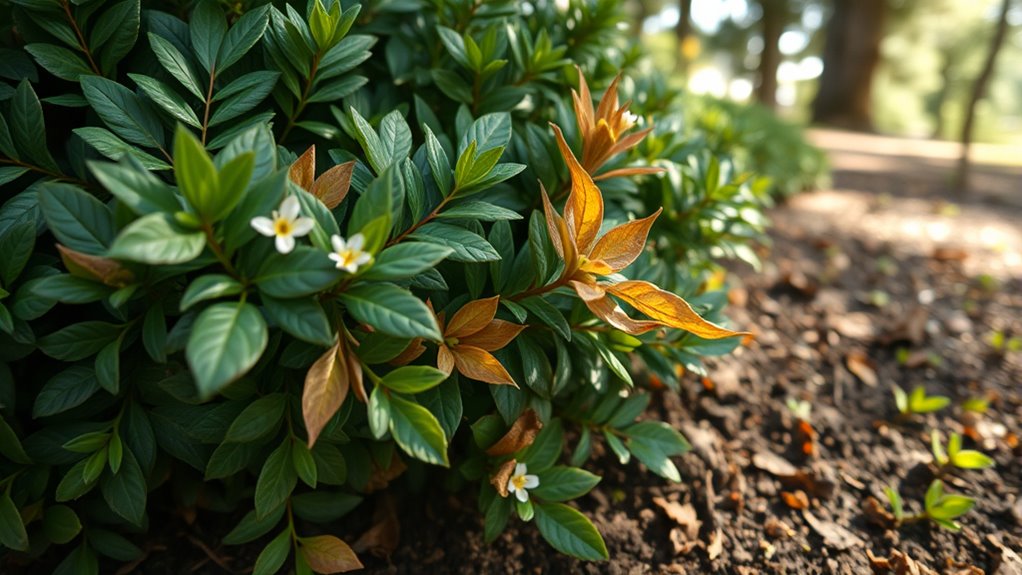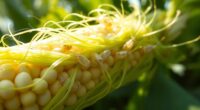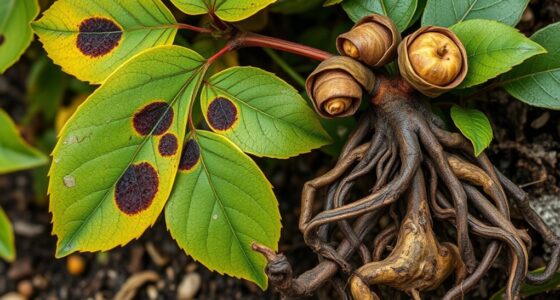If your Pieris is struggling or dying, start by checking the soil pH—aim for 5.0 to 6.5—and make sure it’s well-draining to avoid root rot. Assess the light; Pieris prefers partial shade and can suffer in direct sun or too little light. Look for signs of Phytophthora root rot like yellow leaves, wilting, and dark roots. Also, inspect for pests or fungal issues. Keep these factors in check; further tips could help your plant bounce back.
Key Takeaways
- Check if the soil pH is between 5.0 and 6.5; improper pH impairs nutrient uptake.
- Ensure the plant receives partial shade and isn’t exposed to harsh direct sunlight.
- Inspect roots for dark, mushy areas indicative of Phytophthora root rot.
- Regularly examine leaves and stems for pests, fungal signs, or abnormal discoloration.
- Improve drainage, prune dead branches, and apply acid-loving fertilizer to promote recovery.
Assessing Soil Quality and Drainage

To guarantee your Pieris plant thrives, start by evaluating the soil quality and drainage. Pieris prefers acidic soil with a pH between 5.0 and 6.5; if the soil isn’t sufficiently acidic, the plant may struggle to absorb essential nutrients, leading to nutrient deficiency. Check the soil’s texture—well-draining soil prevents water from pooling around the roots, which can cause root rot. If your soil drains poorly, consider amending it with organic matter like peat moss or compost to improve aeration and acidity. Test the soil regularly to assure it maintains the best acidity level. Healthy soil supports strong growth and vibrant foliage, while poor drainage or incorrect pH can weaken your plant and make it more susceptible to disease. Additionally, proper soil conditions can promote environmentally sustainable growth by ensuring the plant receives adequate nutrients without over-reliance on chemical amendments.
Evaluating Light Conditions
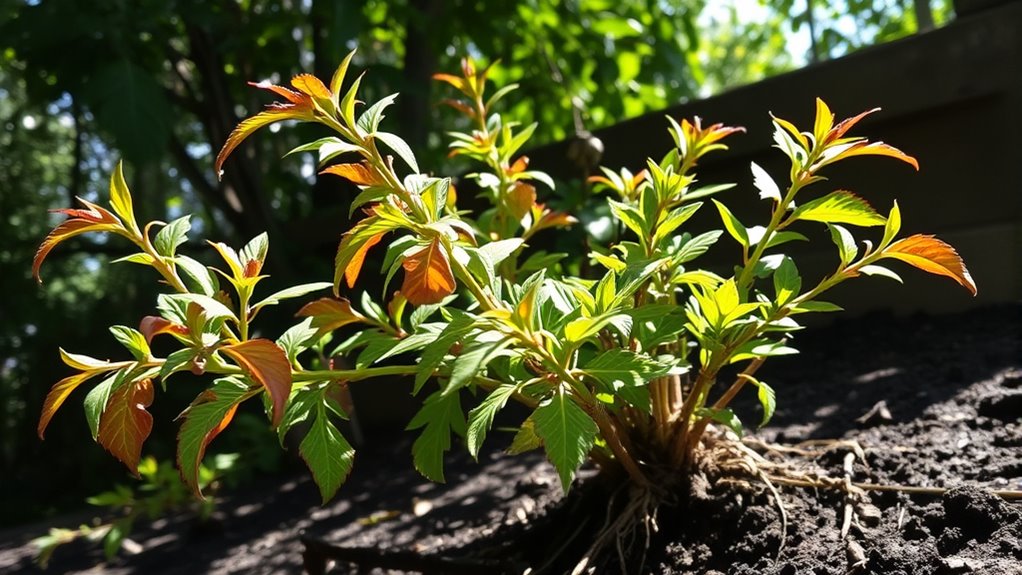
Pieris plants thrive best when they receive the right amount of light, making it essential to evaluate your garden’s light conditions carefully. Understanding your plant’s shade tolerance and sunlight requirements helps guarantee healthy growth. Pieris generally prefers partial shade but can tolerate some sun, especially in cooler climates. Too much direct sunlight, especially in hot afternoons, can scorch their leaves and cause stress. Conversely, too little light can lead to poor flowering and weak growth. Observe your garden throughout the day to see how much sunlight your planting area gets. If your garden is mostly shaded, consider planting Pieris where it will receive dappled or morning sun. Adjusting placement based on light conditions can considerably improve your plant’s health and vibrancy. Additionally, light exposure influences the plant’s susceptibility to diseases like Phytophthora, so maintaining optimal lighting can help prevent such issues. Proper light management can also enhance the plant’s overall resilience and reduce the risk of disease susceptibility.
Identifying Symptoms of Phytophthora Root Rot
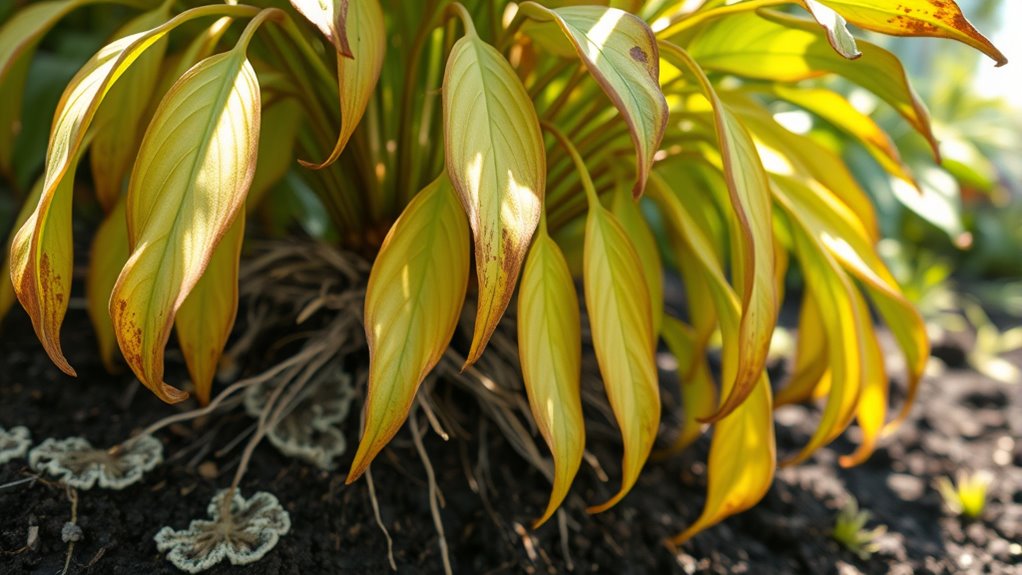
Recognizing the symptoms of Phytophthora root rot early can save your Pieris plant from severe damage. This fungal infection causes root rot, leading to weakened roots that can’t absorb water or nutrients properly. Look for signs like yellowing or browning leaves, especially at the tips, and overall wilting despite adequate watering. You might notice dark, mushy roots when you gently inspect the base of the plant—these are typical of root rot. The soil may smell sour or foul, indicating fungal activity. As the disease progresses, dieback occurs, and the plant’s growth slows drastically. Catching these symptoms early allows you to act quickly, reducing the spread of the fungal infection and increasing your chances of saving your Pieris. Additionally, understanding machine learning algorithms can help in developing early detection systems for plant diseases, potentially preventing widespread damage.
Inspecting for Pests and Diseases

Regularly inspecting your Pieris for pests and diseases is essential to maintaining its health. Look closely at leaves, stems, and the undersides of foliage for signs of pest infestations or fungal infections. Early detection helps prevent serious damage and spread. Keep an eye out for discolored, distorted, or sticky leaves, which can indicate pests like aphids or scale. Also, watch for fuzzy or moldy growths that suggest fungal infections. Regularly check for:
- Presence of insects or eggs on leaves and stems
- Sticky residue or honeydew from pests
- Fungal spots or powdery coatings
- Wilting or yellowing leaves
- Implementing measures such as automation in garden care can help monitor plant health more efficiently. Incorporating preventive practices like proper pruning and soil management further supports plant resilience and reduces susceptibility to diseases. Additionally, understanding home security system costs can help ensure your gardening tools and supplies are safely stored.
Implementing Recovery and Preventative Measures

To effectively support your Pieris’s recovery and prevent future issues, you should implement targeted measures promptly. Start by using proper pruning techniques to remove dead or damaged branches, which encourages healthy growth and improves air circulation. Be careful not to over-prune, as this can stress the plant. Next, apply fertilizer specifically formulated for acid-loving plants to restore nutrient balance. Follow the recommended dosage to avoid overfeeding, which can harm the roots. Mulching around the base also helps retain soil moisture and suppress weeds. Regularly monitor your plant’s health, adjusting care as needed. Additionally, inspecting for soil issues and ensuring proper drainage can prevent root rot. Proper watering practices are also essential for preventing common problems like disease and pests. Incorporating sound vibrations or gentle music into your plant care routine may promote a calming environment that supports recovery. By combining careful pruning with strategic fertilizer application, you’ll promote vigorous growth and help your Pieris recover fully while reducing the risk of future problems.
Frequently Asked Questions
Can Overwatering Cause Pieris to Die Even With Proper Soil Drainage?
Yes, overwatering can cause your Pieris to die even if the soil drains well. Excess water can lead to root rot, weakening the plant’s roots and making it vulnerable to pest infestations. When roots stay constantly wet, they can’t absorb nutrients properly, which stresses the plant and increases its risk of disease. So, always water appropriately and make certain of good drainage to keep your Pieris healthy.
What Are the Signs of Nutrient Deficiencies in Pieris Plants?
You’ll notice nutrient deficiency indicators in your Pieris through symptoms like yellowing leaves, stunted growth, or poor flowering. Nutrient symptoms often include pale or discolored foliage, especially between veins, and leaf edges may turn brown or curl. Watch for these deficiency indicators to determine if your plant needs fertilization. Addressing these nutrient symptoms promptly helps restore your Pieris’s health and encourages vibrant, lush growth.
How Does Temperature Fluctuation Affect Pieris Health?
Temperature fluctuations can cause significant temperature stress for your Pieris, affecting its overall health. Sudden seasonal changes force your plant to adapt quickly, which can weaken its immune system and lead to leaf scorch or dieback. To help your Pieris thrive, guarantee it’s protected from extreme cold or heat, providing some shade during hot seasons and mulching during winter. Proper seasonal adaptation keeps your plant resilient and vibrant.
Are There Specific Fertilizers Recommended for Pieris Recovery?
Coincidences often lead you to better plant care. For Pieris recovery, consider using organic fertilizers that promote healthy growth. Foliar feeding is an effective method, allowing nutrients to be absorbed quickly through the leaves. Look for organic options rich in nitrogen, phosphorus, and potassium to boost your plant’s resilience. Applying these fertilizers carefully can help revive your Pieris, supporting its overall health and encouraging new, vibrant growth.
How Often Should I Prune to Prevent Disease Spread?
You should prune your Pieris regularly, about once or twice a year, to promote healthy growth and prevent disease spread. Focus on removing dead or diseased branches promptly, especially after flowering. Proper pruning maintains airflow and reduces moisture buildup, which helps prevent fungal infections and other diseases. Keep your pruning tools sanitized to avoid transmitting pathogens. Consistent, careful pruning is key for disease prevention and keeping your Pieris thriving.
Conclusion
If your pieris is struggling, addressing soil, light, and disease issues can turn things around. Did you know that Phytophthora root rot causes up to 30% of pieris deaths worldwide? By inspecting for pests, improving drainage, and providing proper light, you give your plant a fighting chance. With a little effort, you can revive your pieris and enjoy its beautiful blossoms again. Don’t give up—your plant’s health is worth it.
